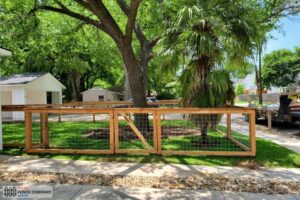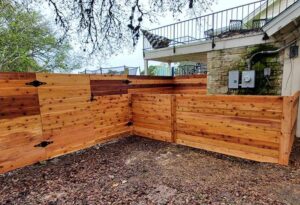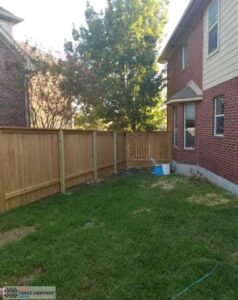Small Yard, Big Feel: Fence Ideas for Narrow Lots & Alleys
TL;DR:
Narrow Austin lots don’t need tall, heavy walls that box you in. You’ll get a bigger-feeling yard with a fence plan that balances height, panel style, gate strategy, and corners—plus airflow for those summer afternoons. Think slimmer posts, tight seams where privacy matters, lighter profiles where views are beneficial, and gates that don’t encroach on square footage. If you’d like a small-space plan tailored to your block and microclimate, the team at Atlas Fence Company can map options that look great and actually work.
Table of Contents
ToggleWhy Small Yards Need a Different Fence Strategy
On a compact lot—think Hyde Park bungalows, East Austin alley homes, or ADUs behind older houses—every inch counts. The goal isn’t simply “privacy,” it’s privacy plus:
- The sensation of breathing room
- Straight, tidy lines so the space reads larger
- Corners that don’t pinch circulation paths
- Gates that work daily without gobbling footage
The right design solves all four. That usually means mixing a solid privacy line—often achieved with a privacy fence—where neighbors are closest, with lighter profiles where a view, breeze, or borrowed light helps the yard feel open.
What to measure before you fall in love with a look
A great plan starts with a tape, a sketch, and a few notes:

- Property line and any setback/easement realities (especially along alleys and utility runs).
- Linear footage and turns—mark where trash/recycling carts and lawn tools actually move.
- Grade changes—even subtle slopes change post heights and clearances.
- Patio doors and windows—note their eye-level position from both seated and standing positions.
- Hot zones—where you need privacy most (grill, seating, hot tub, kitchen window alignment).
When planning, also consider which fencing material best suits your needs in terms of durability, appearance, and local requirements.
Bring that sketch to your estimator, and you’ll skip weeks of “what ifs.”
Heights, sightlines, and where privacy really matters
Defaulting to the tallest possible fence can make a compact yard feel shorter and heavier. Instead:
- Place the maximum height where you actually need it (e.g., on a side run across from a neighbor’s windows, or directly behind the grill/patio seating).
- Consider step-downs on the sunny side to let light and breeze in.
- If your rear line faces a greenbelt or alley, try a lighter profile there for depth and air.
The trick is aligning height with use—protect the places you sit and cook; relax the places you only pass by.
Panel styles that make compact spaces feel bigger
Panel choice changes how your eye reads distance:
- Board-on-board gives true privacy (no peek-through as boards season) and cleaner edges for a polished, “finished yard” look.
- Horizontal profiles can “widen” small yards visually, but keep the board stack refined (slats too tall look bulky).
- Shadowbox adds texture and airflow without fully open gaps.
- Open ornamental (iron/aluminum) at strategic segments borrows landscape depth and keeps air moving.
Wood fencing remains a popular choice for small yards due to its versatility and classic appeal, fitting well with many panel styles.
If you’re still exploring what fits your home’s look, scan Popular Fence Styles in Austin to see how profiles pair with different architectural styles—then adapt them for your space rather than copying wholesale.
Gate choices that save precious square footage
Gates are where small yards win or lose everyday convenience. The wrong gate steals turning radius, scrapes on grade, or needs a three-point maneuver to carry groceries in. Smart options:
- Narrow, purposeful pedestrian gates at 36–42 inches where tools and carts pass.
- Outswing vs. inswing based on the tighter side—outswing off a cramped path keeps your inside corner free.
- Lift-off or adjustable hinges to accommodate small grade changes and seasonal movement.
- Sliding/track solutions for alley approaches where a swing leaf would block cars or trash carts.
If gate traffic is your bottleneck, start by exploring gate options that match your daily flow during the fence installation . We can mix a compact walk gate with a wider, occasional-use access point so you’re not opening a giant leaf for small tasks.
Corners, turns, and alley approaches that don’t feel cramped

Tight spaces get pinched by bad corners. A few ways to keep them open:
- Chamfer or radius inward corners near doors and sheds to widen the path.
- Use a return panel to hide the raw edge of privacy boards when the corner faces your patio.
- In alleys, confirm the approach arc for vehicles and carts before you size a driveway or shop gate.
- Step fence tops cleanly across the grade so the sightline reads level, not wavy.
These details matter most in yards you use daily—tiny improvements in the corners create a surprising amount of calm.
Airflow, shade, and heat management in Central Texas
Austin summers demand airflow. Over-closing a yard traps heat, so plan for:
- Open or lighter segments where breezes enter the yard (often the rear or a high corner).
- Shade strategy—a slightly taller side run on the west can block harsh late-day sun while the rear stays lighter for airflow.
- Vegetation spacing—keep shrubs a few inches off the line so leaves don’t block the only breeze you get at dusk.
Design for the microclimate you experience at 5–7 p.m.—that’s when you’ll feel the difference.
Noise, pets, and day-to-day durability in tight spaces
Small yards are high-traffic yards. Plan for longevity at the spots that get hammered:
- Rot/kick boards at the bottom to absorb mower wheel scrapes and pet paw action.
- Tighter seam control near seating and kids’ play zones to cut chatter and peek-through.
- Heavier gate hardware where usage is constant; latches that self-catch even when your hands are full.
- Anti-dig details (mesh apron or concrete ribbon) for terriers and escape artists. These durability features provide essential protection for both pets and property in small yards.
A small yard lives large when the fence absorbs daily life without wobbling or rattling.
Materials that fit small yards (without big upkeep)
Selecting the best materials is crucial for small yards, as it ensures your fence will be durable, secure, and require minimal maintenance over time.
- Cedar privacy is still the king for warmth and adaptable looks. Favor tight knots and consistent thickness so boards season evenly.
- Ornamental aluminum offers an open profile with minimal maintenance—great where you want airflow and borrowed views.
- Metal fencing is a durable and secure choice for both residential and commercial properties, available in decorative and modern styles to suit various aesthetics.
- Composite excels in tiny, sun-baked yards where stain cycles are challenging to maintain; consider it for the most visible, hottest areas.
- Chain link with slats can work in alleys and utility edges; keep tension tight and the look clean.
Finish and fastener choices matter more in tight spaces because you sit closer to the fence—refined edges look better every day.
Working with a Local Fence Company: What to Know and Ask
Choosing the right Austin fence company can make all the difference in your fence installation or fence repair experience. Start by seeking out a fence company that offers a free estimate and takes the time to understand your property’s unique needs. During your initial consultation, ask about the types of materials they recommend—whether it’s a classic wood fence made from western red cedar or treated pine, a durable chain link fence, or a fully custom fence design.
A reputable Austin fence provider will walk you through the entire fence installation process, from design to final walkthrough, ensuring you’re comfortable with every step. Don’t hesitate to ask about their approach to quality, their track record for exceptional customer service, and how they handle any issues that might arise after your new fence is installed. The best companies are transparent about their warranties and maintenance tips, helping you protect your investment for years to come. Whether you’re looking for a traditional cedar look or a low-maintenance chain link solution, working with a local expert ensures your fence is built to last in the Austin climate.
Protecting Your Investment: Maintenance and Longevity Tips
To keep your fence project looking great and performing well, a little maintenance goes a long way—especially in the unpredictable Texas climate. For wood fences, applying a high-quality sealant or stain helps preserve the natural beauty of your cedar fence and protects against sun, rain, and humidity. Chain link fences are known for their durability, but it’s still wise to check for rust or loose fittings, especially after storms.
If you’re considering fence replacement or adding to your property, always confirm your property lines, building setback lines, and local fence height regulations before starting. An experienced Austin fence contractor can help you navigate these details, ensuring your residential fences or commercial fence not only look great but also boost your curb appeal and property value. With the right care and expert guidance, your fence will protect your property and maintain its classic look for years to come.
Common mistakes and easy wins
Mistake: Over-height everywhere
Win: Concentrate on the maximum height where people sit; relax where you only walk.
Mistake: One giant driveway or shop gate for all access
Win: A compact daily pedestrian gate plus an occasional-use wider opening saves space and money.
Mistake: Bulky corners and wasted turning radius
Win: Chamfer corners and use outswing where inside space is precious.
Mistake: Rail-facing interiors that create toe-holds
Win: Keep the interior smooth; place rails to the outside where feasible.
Mistake: Ignoring grade and drainage at the bottom edge
Win: Step bottoms cleanly and use rot boards so ground contact doesn’t create wavy lines.
Paying attention to these details ensures the job is done right the first time.
Design playbooks for three real-world small lots
These design playbooks are tailored to suit different types of properties, from townhomes to ADUs and corner bungalows, ensuring the correct fencing solution for each property type.

Townhome courtyard with a single side path
- Privacy boards along the neighbor side; lighter rear panel to the greenbelt.
- A 36–42” pedestrian gate outswinging to the drive keeps the path clear.
- Horizontal cap and trim for a polished, “finished room” feel.
ADU lot with alley access
- Compact sliding gate to avoid blocking the alley apron.
- Board-on-board along the main house side for acoustic calm.
- Open ornamental at the back of the ADU yard for airflow and depth.
Corner bungalow with a tiny patio
- Taller west run for shade; standard height elsewhere for light.
- Chamfered corner by the grill to ease traffic around the table.
- Smooth interior face, kick board, and a self-catching latch for hands-full moments.
Thinking About Financing Your Fence Project
A new fence project is an investment in your property’s security, privacy, and value—but it doesn’t have to strain your budget. Many fence companies in Austin offer flexible financing options or can connect you with trusted lenders who understand the needs of homeowners and business owners alike. When exploring financing, consider the full scope of your fencing project—from the cost of materials and labor to any required permits.
A dedicated project manager from a reputable Austin fence company can help you map out a realistic budget and timeline, whether you’re planning a complete fence installation or a targeted fence repair. With innovative financing and a focus on quality craftsmanship, you can achieve the perfect fence to meet your fencing needs and enhance your property value—all while keeping your project on track and stress-free.
Budget, phasing, and what to prioritize
If funds are tight, spend first on the pieces that change how your yard feels:
- Corners and gates—they dictate daily convenience.
- The panel you face most from the patio or kitchen window—upgrade here for looks and seams.
- The bottom edge—rot board or clean step-downs to keep lines straight over time.
Careful planning and prioritization are key to a successful fencing construction project, especially in small yards.
You can come back for accent screens, trellises, or lighting later once the bones are right. For build details and how we spec posts, footings, and fasteners on tight sites, skim our fence installation overview so you know exactly how we construct for longevity.
Frequently Asked Questions
Will a horizontal fence make my narrow yard look wider?
Often, yes—especially with a wood fence featuring modest slat height and crisp spacing. Keep it refined; overly tall slats can feel bulky in tight spaces.
How do I prevent my gate from eating space?
Choose to install outswing where the inside path is tight, or use a sliding gate on alley approaches. Adjustable hinges help you fine-tune clearances after seasonal movement.
Can I mix materials in a tiny yard?
Absolutely. Many small lots use cedar privacy along neighbors and a short stretch of ornamental aluminum at the rear for airflow and borrowed view.
What about noise from an alley or busy street?
Consider a commercial fence with board-on-board placement to mitigate the exposure to traffic, and combine it with planting to diffuse reflections. Seam control matters as much as height.
Do I need HOA approval?
If you’re in an HOA, yes—usually for height, style, and color. We’ll help put together a simple packet and a clean sketch for approval.
What sets your Austin fence installation apart?
Our Austin fence installation services stand out due to our local expertise, comprehensive process—including permits, material selection, and attention to detail—and our commitment to customer satisfaction. We are dedicated to delivering quality craftsmanship on every project, and our highly skilled team ensures your fence is built to last. Many customers in Austin, both homeowners and business owners, have trusted us for their fencing needs. One recent client shared, “We couldn’t be happier with how our new fence turned out—it’s both beautiful and sturdy.”
Additional Resources and Support
 For property owners in Central Texas, staying informed about local fence installation guidelines and fence height restrictions is key to a smooth project. The City of Austin offers helpful resources on everything from permits to setback requirements, so you can be confident your new or repaired fence meets all regulations.
For property owners in Central Texas, staying informed about local fence installation guidelines and fence height restrictions is key to a smooth project. The City of Austin offers helpful resources on everything from permits to setback requirements, so you can be confident your new or repaired fence meets all regulations.
When choosing a fence company, look for an experienced team with deep knowledge of the Austin area and a reputation for excellent communication throughout the fence installation process. Many satisfied customers in Austin have found peace of mind with companies that deliver quality craftsmanship and reliable service—ensuring your yard and property are both protected and enhanced. Whether you’re installing a new fence or updating an old fence, the right partner will provide exceptional strength and natural beauty that lasts for years, making your property stand out in any neighborhood.
Your next step
Want a yard that feels bigger without sacrificing privacy? We’ll measure the space, mark the turning radii and sightlines, and provide you with two or three innovative layouts so you can choose with confidence. We offer free estimates to help you get started with your small yard fence project in Austin. When you’re ready to explore options for your block, request a free estimate or call (512) 366-8108 and let us know which corners or paths cause you the most trouble.
